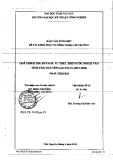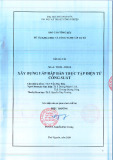
RESEARC H Open Access
Large-scale data integration framework provides
a comprehensive view on glioblastoma
multiforme
Kristian Ovaska
1
, Marko Laakso
1†
, Saija Haapa-Paananen
2†
, Riku Louhimo
1
, Ping Chen
1
, Viljami Aittomäki
1
,
Erkka Valo
1
, Javier Núñez-Fontarnau
1
, Ville Rantanen
1
, Sirkku Karinen
1
, Kari Nousiainen
1
,
Anna-Maria Lahesmaa-Korpinen
1
, Minna Miettinen
1
, Lilli Saarinen
1
, Pekka Kohonen
2
, Jianmin Wu
1
,
Jukka Westermarck
3,4
, Sampsa Hautaniemi
1*
Abstract
Background: Coordinated efforts to collect large-scale data sets provide a basis for systems level understanding of
complex diseases. In order to translate these fragmented and heterogeneous data sets into knowledge and
medical benefits, advanced computational methods for data analysis, integration and visualization are needed.
Methods: We introduce a novel data integration framework, Anduril, for translating fragmented large-scale data
into testable predictions. The Anduril framework allows rapid integration of heterogeneous data with state-of-the-
art computational methods and existing knowledge in bio-databases. Anduril automatically generates thorough
summary reports and a website that shows the most relevant features of each gene at a glance, allows sorting of
data based on different parameters, and provides direct links to more detailed data on genes, transcripts or
genomic regions. Anduril is open-source; all methods and documentation are freely available.
Results: We have integrated multidimensional molecular and clinical data from 338 subjects having glioblastoma
multiforme, one of the deadliest and most poorly understood cancers, using Anduril. The central objective of our
approach is to identify genetic loci and genes that have significant survival effect. Our results suggest several novel
genetic alterations linked to glioblastoma multiforme progression and, more specifically, reveal Moesin as a novel
glioblastoma multiforme-associated gene that has a strong survival effect and whose depletion in vitro significantly
inhibited cell proliferation. All analysis results are available as a comprehensive website.
Conclusions: Our results demonstrate that integrated analysis and visualization of multidimensional and
heterogeneous data by Anduril enables drawing conclusions on functional consequences of large-scale molecular
data. Many of the identified genetic loci and genes having significant survival effect have not been reported earlier
in the context of glioblastoma multiforme. Thus, in addition to generally applicable novel methodology, our results
provide several glioblastoma multiforme candidate genes for further studies.
Anduril is available at http://csbi.ltdk.helsinki.fi/anduril/
The glioblastoma multiforme analysis results are available at http://csbi.ltdk.helsinki.fi/anduril/tcga-gbm/
* Correspondence: sampsa.hautaniemi@helsinki.fi
†Contributed equally
1
Computational Systems Biology Laboratory, Institute of Biomedicine and
Genome-Scale Biology Research Program, University of Helsinki,
Haartmaninkatu 8, Helsinki, FIN-00014, Finland
Full list of author information is available at the end of the article
Ovaska et al.Genome Medicine 2010, 2:65
http://genomemedicine.com/content/2/9/65
© 2010 Ovaska et al.; licensee BioMed Central Ltd. This is an open access article distributed under the terms of the Creative Commons
Attribution License (http://creativecommons.org/licenses/by/2.0), which permits unrestricted use, distribution, and reproduction in
any medium, provided the original work is properly cited.





























